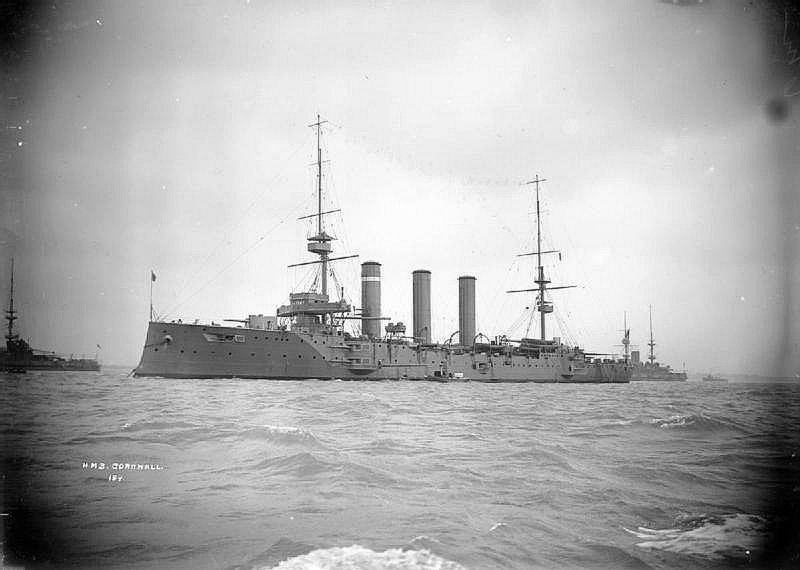Enregistrez-vous
ARMATEURS PASSES
ARMATEURS PRESENTS
NAVIRES MARCHANDS
NAVIRES MILITAIRES
OFF-SHORE
AUTRES IMAGES

| Précedente Suivante |
 |
| HMS Cornwall |
| Career (United Kingdom) Name: HMS Cornwall Namesake: Cornwall Builder: Pembroke Royal Dockyard, Wales Laid down: 11 March 1901 Launched: 29 October 1902 Completed: 1 December 1904 Fate: Sold for scrap, 7 July 1920 General characteristics Class and type: Monmouth-class armoured cruiser Displacement: 9,800 long tons (10,000 t) (normal) Length: 463 ft 6 in (141.3 m) (o/a) Beam: 66 ft (20.1 m) Draught: 25 ft (7.6 m) Installed power: 22,000 ihp (16,000 kW) 31 water-tube boilers Propulsion: 2 ? shafts 2 ? 4-cylinder triple-expansion steam engines Speed: 23 knots (43 km/h; 26 mph) Complement: 678 Armament: ? 2 ? twin, 10 ? single BL 6-inch Mk VII guns ? 10 ? single QF 12-pdr 12 cwt guns[Note 1] ? 3 ? QF 3-pounder Hotchkiss guns ? 2 ? single 18-inch torpedo tubes Armour: ? Belt: 2?4 in (51?102 mm) ? Decks: .75?2 in (19?51 mm) ? Barbettes: 5 in (127 mm) ? Turrets: 5 in (130 mm) ? Conning tower: 10 in (254 mm) ? Bulkheads: 5 in (127 mm) HMS Cornwall was one of 10 Monmouth-class armoured cruisers built for the Royal Navy in the first decade of the 20th century. She was assigned to the 2nd Cruiser Squadron of the Channel Fleet upon completion in 1903. She was refitted in 1907 in preparation for service as a training ship with the 4th Cruiser Squadron on the North America and West Indies Station beginning in 1908. Cornwall ran aground in 1911 while trying to free another cruiser. She captured a German merchant ship days after the beginning of World War I in August 1914 and was then sent to the Central Atlantic to search for German commerce raiders. Later that year, she was assigned to the squadron that destroyed the German East Asia Squadron at the Battle of the Falklands. She supported Allied operations in the South-West Africa Campaign in early 1915 and blockaded a German cruiser in East Africa before participating in the Dardanelles Campaign later that year. She was later transferred to the China Station and remained there until 1917. She was reassigned to the North America Station that year for convoy escort duties and remained on that duty for the rest of the war. Cornwall became a training ship in 1919 before she was paid off later that year and then sold for scrap in 1920. Design and description Cornwall was designed to displace 9,800 long tons (10,000 t). The ship had an overall length of 463 feet 6 inches (141.3 m), a beam of 66 feet (20.1 m) and a deep draught of 25 feet (7.6 m). She was powered by two 4-cylinder triple-expansion steam engines, each driving one shaft, which produced a total of 22,000 indicated horsepower (16,000 kW) and gave a maximum speed of 23 knots (43 km/h; 26 mph). The engines were powered by 31 Babcock & Wilcox boilers. [1] She carried a maximum of 1,600 long tons (1,600 t) of coal and her complement consisted of 678 officers and enlisted men. Her main armament consisted of fourteen breech-loading (BL) 6-inch Mk VII guns.[3] Four of these guns were mounted in two twin-gun turrets, one each fore and aft of the superstructure and the others positioned in casemates amidships. Six of these were mounted on the main deck and were only usable in calm weather. They had a maximum range of approximately 12,200 yards (11,200 m) with their 100-pound (45 kg) shells. Ten quick-firing (QF) 12-pounder 12 cwt guns were fitted for defence against torpedo boats. Cornwall also carried three 3-pounder Hotchkiss guns and two submerged 18-inch torpedo tubes. Beginning in 1915, the main deck six-inch guns of the Monmouth-class ships were moved to the upper deck and given gun shields. Their casemates were plated over to improve seakeeping. The twelve-pounder guns displaced by the transfer were repositioned elsewhere. At some point in the war, 3 three-pounder anti-aircraft guns were installed on the upper deck. The ship's waterline armour belt had a maximum thickness of four inches (102 mm) and was closed off by five-inch (127 mm) transverse bulkheads. The armour of the gun turrets and their barbettes was four inches thick while the casemate armour was five inches thick. The protective deck armour ranged in thickness from .75?2 inches (19?51 mm) and the conning tower was protected by ten inches (254 mm) of armour. Construction and service Cornwall, named to commemorate the English county, was laid down at Pembroke Royal Dockyard, Wales, on 11 March 1901, and launched on 29 October 1902. She was completed on 1 December 1904[1] and was initially assigned to the 2nd Cruiser Squadron of the Channel Fleet. In December 1906 she began a refit that lasted through 1907. She became a cadet training ship in January 1908 and was assigned to the 4th Cruiser Squadron on the North America and West Indies Station. On 6 August 1911 Cornwall ran aground on Pinnacle Rock, off Cape Sable Island in Nova Scotia while assisting the protected cruiser HMCS Niobe, which had also run aground. Both cruisers were refloated and Cornwall was repaired at His Majesty's Canadian Dockyard, Halifax. She returned to Britain for the July 1914 Fleet review at Spithead and was reassigned to the 5th Cruiser Squadron at the beginning of the war in August. Cornwall captured the German merchantman SS Syra on 6 August and continued to search for German raiders in the Central Atlantic. She then proceeded to the Falkland Islands with the squadron commanded by Vice-Admiral Doveton Sturdee. Battle of the Falklands Upon arrival at Port Stanley on 7 December, Sturdee gave permission for Cornwall to put out her fires to clean her boilers and repair one engine. He planned to recoal the entire squadron the following day from the two available colliers and to begin the search for the East Asia Squadron the day after. Vice-Admiral Maximilian von Spee, commander of the German squadron, had other plans and intended to destroy the radio station at Port Stanley on the morning of 8 December. The appearance of two German ships at 07:30 caught Sturdee's ships by surprise although they were driven off by 12-inch (300 mm) shells fired by the predreadnought battleship Canopus when they came within range around 09:20. This gave time for Cornwall to reassemble her engine and raise steam, although she had not even started to recoal. The squadron cleared the harbour by 10:30 and Sturdee ordered, "general chase". His two battlecruisers were the fastest ships present and inexorably began to close on the German cruisers. They opened fire at 12:55 and began to straddle the light cruiser Leipzig, the rear ship in the German formation. It was clear to Spee that his ships could not outrun the battlecruisers and that the only hope for any of his ships to survive was to scatter. So he turned his two armoured cruisers around to buy time by engaging the battlecruisers and ordered his three light cruisers to disperse at 13:20. In accordance with Sturdee's plans, Cornwall, her sister ship, Kent, and the light cruiser Glasgow immediately set off in pursuit while the battlecruisers and the slow armoured cruiser Carnarvon dealt with the German armoured cruisers. At 14:45 Glasgow, the fastest of the British cruisers, was close enough to Leipzig to open fire and the two ships exchanged salvos and scoring the occasional hit. An hour later, the Germans scattered in different directions; Cornwall and Glasgow pursued Leipzig while Kent went after N?rnberg. Cornwall closed on Leipzig at full speed, trusting to her armour to keep out the German's 105-millimetre (4.1 in) shells, while the unarmoured Glasgow manoeuvered at a distance. The range from Cornwall was 7,000 yards (6,400 m) at 18:00 and her shells set Leipzig on fire. Five minutes later, the German ship had ceased firing and the British ships closed to 5,000 yards (4,600 m) to see if she would surrender. One last gun fired and Leipzig did not strike her colours so the British fired several additional salvos at 19:25. The German captain had mustered his surviving crewmen on deck preparatory to abandoning ship, but the ship's flag could not be reached because it was surrounded by flames, and the British shells wrought havoc on the assembled crew. Leipzig fired two green flares at 20:12 and the British ships closed to within 500 yards (460 m) and lowered boats to rescue the Germans at 20:45. Their ship capsized at 21:32 but only 18 men were rescued. Leipzig had hit the British cruiser 18 times, but she did not lose a single man. After the battle, Cornwall was sent to support operations in German South-West Africa in January 1915 and then reinforced the blockade of the light cruiser K?nigsberg in the Rufiji River in East Africa in April. Later that year she was sent to support the Dardanelles Campaign and then to the China Station. She returned to the Atlantic in 1917 to escort convoys between North American and the Britain. She became a cadet training ship in 1919 at Devonport before she was sold for scrap on 7 June 1920. |
| Username | |
| Armateur | Royal Navy |
| Ship manager | |
| Numéro IMO | |
| Type de navire | Cruiser |
| Année et chantier de construction | 1904 Pembroke Royal Dockyard, Wales |
| Date | |
| Lieu | |
| Téléchargée le | 18/05/2015 |
| Dimension | 1200 x 855 |
| visites | 1541 |















